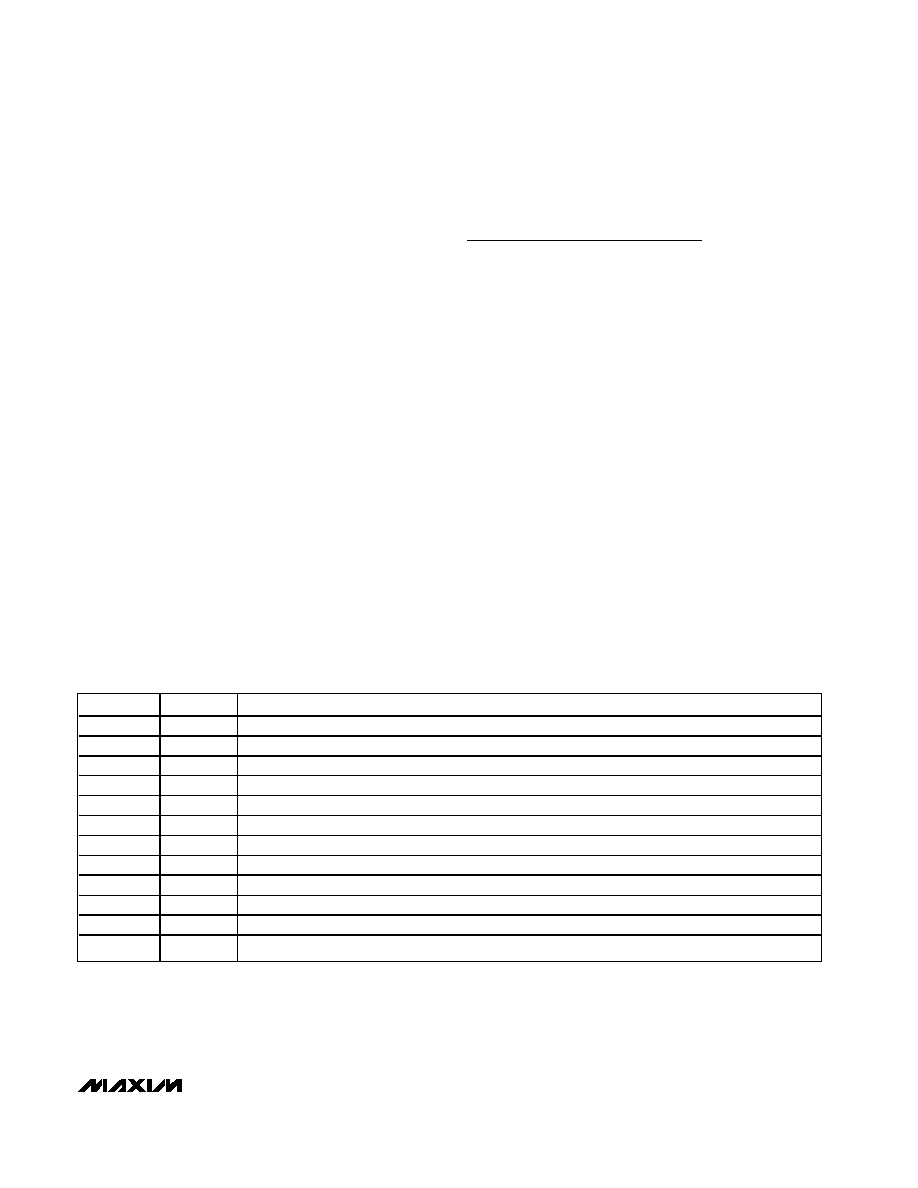MAX1132EV kit

General Description
The MAX1132 evaluation system (EV system) is a com-
plete, single-channel data-acquisition system, consisting
of a MAX1132 evaluation kit (EV kit) and a Maxim
68HC16MODULE-DIP microcontroller (µC) module. The
MAX1132 is a high-speed, single-channel, 16-bit data
acquisition system. Windows
®
95/98 software provides a
handy user interface to exercise the MAX1132's features.
Order the complete EV System (MAX1132EVC16) for
comprehensive evaluation of the MAX1132 using a PC.
Order the EV kit (MAX1132EVKIT) if the 68HC16MOD-
ULE-DIP module has already been purchased with a pre-
vious Maxim EV system, or for custom use in other µC-
based systems.
The MAX1132 software is designed for use with the com-
plete EV system MAX1132EVC16 (includes 68HC16-
MODULE-DIP module together with MAX1132 EVKIT). If
the MAX1132 evaluation software is not used, the
MAX1132EVKIT board can be purchased by itself, with-
out the µC.
Features
o Proven PC Board Layout
o Complete Evaluation System
o Convenient Test Points Provided On-Board
o Data-Logging Software
o Fully Assembled and Tested
Evaluates: MAX1132/MAX1133
MAX1132 Evaluation Kit
________________________________________________________________ Maxim Integrated Products
1
19-2161; Rev 0; 09/01
MAX1132EVC16 System
Component List
Ordering Information
MAX1132EVKIT Parts List
PART
QTY
DESCRIPTION
MAX1132EVKIT
1
MAX1132 EV kit
68HC16MODULE-DIP
1
68HC16 µC module
List of Files in MAX1132
EV Kit
FILE
DESCRIPTION
INSTALL.EXE
Installs the EV kit files on computer
MAX1132.EXE
Application program
KIT1132.C16
Software loaded into 68HC16 µC
PART
TEMP. RANGE
INTERFACE TYPE
MAX1132EVKIT
0°C to +70°C
User supplied
MAX1132EVC16
0°C to +70°C
Windows software
REFERENCE
QTY
DESCRIPTION
C1, C2
2
10µF 10V B-size tantalum capacitors
C3
1
2.2µF 10V X7R ceramic capacitor
C4
1
0.22µF X 7R cer am i c cap aci tor ( 1206)
C5, C6, C8
3
0.1µF X7R ceramic capacitors (1206)
C7
1
1µF X7R ceramic capacitor (1206)
FB1, FB2
2
Ferrite beads
J1
1
2 x 20 right-angle socket,
SamTec SSW-120-02-S-D-RA
JU1, JU5
2
3-pin headers
JU2, JU3, JU4
2
2-pin headers
R1
1
100k
±1% 1206 resistor
TB1, TB2
2
0.200in screw terminal blocks
TP1
1
9-pin header
U1
1
MAX1132BCAP
U2
1
74HC04 (14-pin SO) hex inverter
None
1
PC board, MAX1132 EV kit
None
1
3.5in software disk, MAX1132 EV kit
None
1
MAX1132 EV kit data sheet
(includes 68HC16MODULE-DIP
manual)
None
1
MAX1132 data sheet
Windows is a registered trademark of Microsoft Corp.
For pricing, delivery, and ordering information, please contact Maxim/Dallas Direct! at
1-888-629-4642, or visit Maxim's website at www.maxim-ic.com.

Evaluates: MAX1132/MAX1133
MAX1132 Evaluation Kit
2
_______________________________________________________________________________________
MAX1132 Stand-Alone EV Kit
The MAX1132EVKIT provides a proven PC board layout
to facilitate evaluation of the MAX1132. It must be inter-
faced to appropriate timing signals for proper opera-
tion. Connect +5V to AV
DD
and connect ground return
to AGND (Figure 1). Refer to the MAX1132 data sheet
for timing requirements.
MAX1132 EV System
The MAX1132EVC16 EV system operates from a user-
supplied +7VDC to +20VDC power supply. Windows
95/98 software running on an IBM PC interfaces to the
EV system board through the computer's serial commu-
nications port. See the Quick Start section for setup and
operating instructions.
Quick Start
Recommended Equipment
Before you begin, the following equipment is needed:
·
MAX1132EVC16 (contains MAX1132EVKIT board
and 68HC16MODULE-DIP)
·
Small DC power supply, such as a 12VDC 0.25A
plug-in transformer, or a +9V battery
·
IBM PC-compatible computer running Windows
95/98
·
Spare serial communications port, preferably a
9-pin plug
·
Serial cable to connect the computer's serial port to
the 68HC16MODULE-DIP
1) Carefully connect the boards by aligning the 40-pin
header of the MAX1132 EV kit with the 40-pin con-
nector of the 68HC16MODULE-DIP module. Gently
press them together. The two boards should be
flush against one another.
2) Check the jumper settings (Table 1).
3) Connect a +7VDC to +20VDC power source to the
µC module at the terminal block located next to the
on/off switch, along the top edge of the µC module.
Observe the polarity marked on the board.
4) Connect a cable from the computer's serial port to
the µC module. If using a 9-pin serial port, use a
straight-through, 9-pin female-to-male cable. If the
only available serial port uses a 25-pin connector, a
standard 25-pin to 9-pin adapter is required. The
EV kit software checks the modem status lines
(CTS, DSR, DCD) to confirm that the correct port
has been selected.
5) Install the MAX1132 EV kit software on your com-
puter by running the INSTALL.EXE program on the
floppy disk. The program files are copied and icons
are created for them in the Windows Start menu.
6) Start the MAX1132 program by opening its icon in
the Start menu.
7) The program prompts you to connect the µC mod-
ule and turn its power on. Slide SW1 to the ON posi-
tion. Select the correct serial port and click OK. The
program automatically downloads KIT1132.C16 to
the module.
8) Apply the input signal across the pins of JU2.
Observe the readout on the screen.
Detailed Description
of Software
The evaluation software main window controls the
active control word bits, serial clock speed, and sample
rate. It displays the voltage and output code, as well as
some statistics of the input signal. A separate graph
window shows the data changing in real time. The
update rate is limited to about 10 samples per second,
due to COM port bandwidth limitations.
Controls
The control word is divided into several fields. To
change the active control word, drop down the appro-
priate field's combo box and select the desired option.
If the QSPI clock is set to STOP, the configuration data
is not sent until the READ button is clicked.
Statistics
The minimum and maximum fields show the lowest and
highest readings acquired. The average and RMS
fields show the running mean and root-mean-square of
the input signal. The Clear button resets the statistics.
To remove offset errors, first apply zero volts to the
active input channel, clear statistics, acquire some
samples, and then check Tare. This offset is now sub-
tracted from all subsequent voltage measurements.
Sampling
To sample data at rates up to 125ksps, select the
Sample menu item, make your selections, and click the
Begin Sampling button. Sample size is restricted to a
power of two to permit FFT processing once the data is
saved to a file. After the samples have been collected,
the data is automatically uploaded to the host and is
graphed. Once displayed, the data can optionally be
saved to a file.

Saving Graphs to Disk
Data in the real-time graph and in sampled data graphs
may be saved to a file. Only the raw output codes are
saved, but voltages may be inferred based on the ref-
erence voltage and the maximum code value.
Evaluating Shutdown
The evaluation software configures the 68HC16's QSPI
submodule to continuously read data from the MAX1132
into the 68HC16. The sample rate is controlled by the
QSPI clock. To evaluate power-saving modes, these
automatic updates must be stopped. First, set the QSPI
clock control to STOP. This reconfigures the 68HC16's
QSPI submodule to stop driving the serial clock. Second,
in the evaluation software's main window, uncheck the
Read Every checkbox. Next, choose the desired software
power-down control word, and click the Read button to
send the new configuration to the MAX1132. If evaluating
the hardware shutdown, move JU2 to the 2-3 position.
Reference Voltage
The evaluation software assumes a +4.096V reference
voltage and a +12V full-scale voltage, unless otherwise
specified. Refer to the MAX1132 data sheet for more
information. To override these values, type the new val-
ues into the appropriate edit box and click the Set V
REF
button.
Detailed Description
of Hardware
The MAX1132 (U1) is a high-speed, single-channel, 16-
bit data-acquisition system. There is no antialiasing filter
provided. The input signal may be applied directly to
JU2. High-impedance signal sources may require an
input buffer, which may be installed in the prototype
area. C4 bypasses the bandgap reference, and C3
bypasses the A/D converter`s voltage reference. When
plugged into the 68HC16MODULE, the AV
DD
and DV
DD
circuits are both powered by +5V. (Figure 1). Refer to the
MAX1132 data sheet.
Evaluating the MAX1133
To change the evaluation software's full-scale voltage
for use with the MAX1133, type 4.096 into the full-scale
edit box and click the Set V
REF
button.
Troubleshooting
Problem: No output measurement. System seems to
report zero voltage, or fails to make a measurement.
Check V
DD
and V
LOGIC
supply voltages. Check the
+4.096V reference voltage using a digital voltmeter.
Use an oscilloscope to verify that the conversion-start
signal is being strobed. Verify that SHDN is being dri-
ven high.
Evaluates: MAX1132/MAX1133
MAX1132 Evaluation Kit
_______________________________________________________________________________________
3
JUMPER
POSITION
FUNCTION
--
1-2
Operate
JU1
Open
SHDN is controlled by 68HC16 module
--
2-3
Shutdown
JU2
Closed
Measure short circuit (zero volts)
--
Open
Apply input signal at JU2
JU3
Closed
Illegal
--
Open*
Enable internal reference, or apply an external reference
JU4
Closed
Disable internal reference
--
Open*
Enable internal reference
--
1
User-programmable output pin P2
JU5
2
User-programmable output pin P1
--
3
User-programmable output pin P0
Table 1. Jumper Functions
*Default configuration

Evaluates: MAX1132/MAX1133
Problem: Unacceptable errors when measuring a
transducer.
Although most signal sources can be connected direct-
ly to the MAX1132's analog input, some high-imped-
ance signal sources may require an input buffer. Check
for settling errors by increasing the acquisition time:
operate the evaluation kit in external clock mode, 32
clocks per conversion, with the QSPI clock at its slow-
est setting.
Problem: Measurements are erratic, unstable; poor
accuracy.
Check the reference voltage and input using a digital
voltmeter. Use an oscilloscope to check for noise.
When probing for noise, keep the oscilloscope ground
return lead as short as possible, preferably less than
1/2in (10mm).
MAX1132 Evaluation Kit
4
_______________________________________________________________________________________
JU3
1
20
19
18
16
14
13
12
11
15
17
REF
REFADJ
AGND
AV
DD
DVDD
AVDD
AVDD
DGND
AVDD
SHDN
P1
P0
P2
SSTRB
AIN
AGND
CREF
CS
DIN
DV
DD
DVDD
DVDD
DGND
SCLK
RST
DOUT
C3
2.2
µF
10V
MAX1132
C2
10
µF
10V
C1
10
µF
10V
2
3
4
5
6
8
9
4
3
2
1
7
10
C4
0.22
µF
C7
1.0
µF
C6
0.1
µF
C5
0.1
µF
JU4
JU2
TB1
FB2
DVDD
TP1-2
J1-29
J1-7
1
2
JU1
3
DVDD
TB2
DVDD
C8
0.1
µF
1
2
JU5
3
TP1-4
TP1-5
J1-38
J1-36
TP1-6
J1-37
TP1-7
J1-31
TP1-8
U2-A
U2-B
74HC04
U2-C
74HC04
5
6
U2-D
74HC04
9
8
U2-F
74HC04
11
10
U2-G
74HC04
13
12
74HC04
J1-35
TP1-3
J1-27
NOTES:
1. MINIMIZE PARASITIC CAPACITANCE OF U1 PIN 11U2 PIN 1.
KEEP THE TRACE SHORT AND KEEP GROUND PLANE 0.025in AWAY.
2. U2 SUPPLY AND GROUND RETURN SHOULD BE ROUTED TO CONNECTOR J1, NOT FLOODED.
FB1
J1-8
J1-1
J1-2
J1-3
J1-4
TP1-1
TP1-2
R1
100k
Figure 1. MAX1132 EV Kit Schematic Diagram

Evaluates: MAX1132/MAX1133
MAX1132 Evaluation Kit
_______________________________________________________________________________________
5
!"#$% &'(()*+,-
.)/0)1#213)45647)568)9:);<=>?5$
0@(()AB'C
&'(()*+,D
0@(()AB(C
.)E#"F)$1>$)>G<)>FF#2"<;)$6)$1<)A0B!
&'(()*+,H
0@(()A''C
.)A0I)E#"F)$1>$)>G<)6?$E?$F
&'(()*+-,
.)/C/JK@
0@(()/C,
.)F<";)<#21$L9#$)46"$G65)86G;3)>";)46"$#"?<MMM
0@(()/CN
0@(()/CO
MMM
0@(()/CH
&'(()*+O,
.)P/CQ!@0HR
0@(()/CS
.)G<4<#T<)F#U$<<"L9#$);>$>)=#<5;
0@(()/CV
0@(()/CW
MMM
0@(()/CD
/&C'
.)F<";)X<G6)81<")G<4<#T#"2);>$>
0@'))@CS
0@'))@CV
0@'))@CW
MMM
0@'))@CD
&'(Q)*YS,,,SSSS
.)41>""<5),3)?"#E65>G3)F#"25<L<";<;3)E;ZSS
F$;))@C,
.)41>""<5),)46[[>";
5;>9)*+O,
.)41>""<5)S)9#$)[>F7
6G;))@C,
F$;))@CN
.)41>""<5)S)46[[>";
5;>9)*+S,
.)41>""<5)N)9#$)[>F7
6G;))@C,
F$;))@CO
.)41>""<5)N)46[[>";
MMM
5;>9)*+\,
.)41>""<5)\)9#$)[>F7
6G;))@C,
F$;))@CH
.)41>""<5)\)46[[>";
/&C))0B/CV
.);#F>95<)A0B!)1>5$)[6;<)#"$<GG?E$
&''))*+-,,-
.)Q!@0ZS]3)0BQCZ-)PSM,O^)I_XR3)/BJ&Z,3)/B_(Z,
0@'))0B/C,
&''))*+,N,O
.)'0/`3)'@&)"6$)?F<;
0@'))0B/CS
&''))*+OD,,
.)"<8aEZ,3)<";aEZSW3)8G>E)$6)X<G6
0@'))0B/CN
.)G?")A0B!)46"$#"?6?F5:)6")>55)41>""<5F
Q0H@b)0B/CS3*+-,,,
.)F$>G$)$1<)A0B!
Q/&C))0B0C3*+-,
.)45<>G)0B!D)9#$
C<>;&66E%
&''))CCS
cFG))BG64<FFd/1>""<5d,
&''))CCV
cFG))BG64<FFd/1>""<5dS
&''))CCW
cFG))BG64<FFd/1>""<5dN
MMM
&''))CCD
cFG))BG64<FFd/1>""<5d\
c[E))C<>;&66E
Listing 1. Reading All Channels with QSPI




